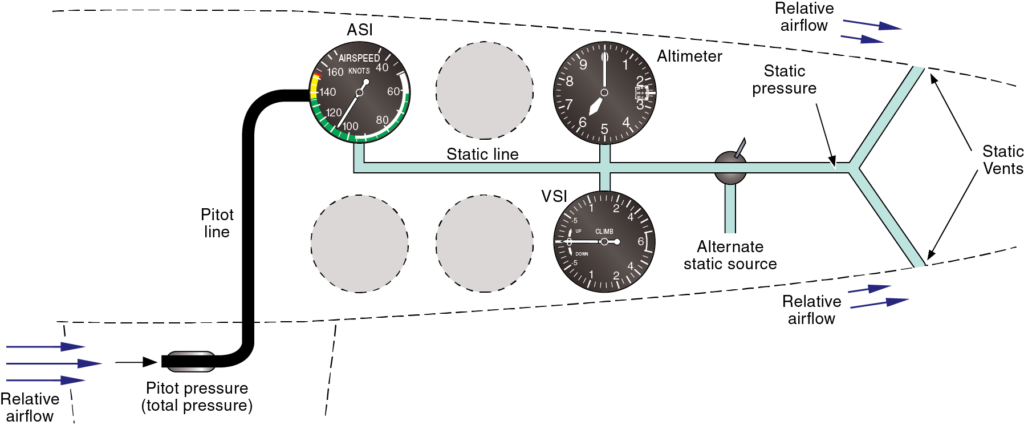The pitot-static system is responsible for the operation of three of the six primary flight instruments, otherwise known as the “six pack.” The three pitot-static instruments include the pressure altimeter, vertical speed indicator, and airspeed indicator (see Figure 1). Understanding how each of these instruments operate is critical to flight safety. Today, we’re going to focus on just one pitot-static instrument, the altimeter, which is an instrument used to measure height (altitude) by responding to atmospheric pressure changes.
In the Instrument Pilot Oral Exam Guide, Jason Blair includes some questions and answers about the pitot-static system and specifically the altimeter that may get you started. (A reference document is in parentheses following each question.)
1. What instruments operate from the pitot/static system? (FAA‑H‑8083‑15)
The pitot/static system operates the altimeter, vertical speed indicator (VSI), and airspeed indicator (ASI). All three instruments receive static air pressure for operation with only the ASI receiving both pitot and static pressure.

2. How does an altimeter work? (FAA‑H‑8083‑15)
A sensitive altimeter is an aneroid barometer that measures the absolute pressure of the ambient air and displays it in terms of feet or meters above a selected pressure level. The “sensitive element” in a sensitive altimeter is a stack of evacuated, corrugated bronze aneroid capsules. The air pressure acting on these aneroids tries to compress them against their natural springiness, which tries to expand them. The result is that their thickness changes as the air pressure changes. Stacking several aneroids increases the dimension change as the pressure varies over the usable range of the instrument.
3. What type of errors is the altimeter subject to? (FAA-H-8083-15)
There are two types of altimeter errors.
a. Mechanical errors—Differences between ambient temperature and/or pressure can cause an erroneous indication on the altimeter.
b. Inherent errors—Nonstandard temperature and pressure.
- Warmer than standard air—The air is less dense, and the pressure levels are farther apart. The pressure level for a given altitude is higher than it would be in air at standard temperature, and the aircraft is higher than it would be if the air were cooler. True altitude is higher than indicated altitude whenever the temperature is warmer than International Standard Atmosphere (ISA).
- Colder than standard air—The air is denser, and the pressure levels are closer together. The pressure level for a given altitude is lower than it would be in air at standard temperature, and the aircraft is lower than it would be if the air were warmer. True altitude is lower than indicated altitude whenever the temperature is colder than ISA.
- Extreme cold altimeter errors—A correctly calibrated pressure altimeter indicates true altitude above mean sea level (MSL) when operating within ISA parameters of pressure and temperature. When operating in extreme cold temperatures (i.e., +10°C to −50°C), pilots may wish to compensate for the reduction in terrain clearance by adding a cold temperature correction.
- High pressure to low pressure—If an aircraft is flown from an area of high pressure to an area of lower pressure without adjusting the altimeter, the true altitude of the aircraft will be lower than the indicated altitude.
- Low pressure to high pressure—If an aircraft is flown from an area of low pressure to an area of higher pressure without adjusting the altimeter, the true altitude of the aircraft will be higher than the indicated altitude.
Remember: High to Low or Hot to Cold—look out below!
4. For IFR flight, what is the maximum allowable error for an altimeter? (FAA‑H‑8083‑15, 14 CFR 43 Appendix E)
If the altimeter is off field elevation by more than 75 feet, with the correct pressure set in the Kollsman window, it is considered unreliable.
5. Define and state how to determine the following altitudes: indicated altitude, true altitude, absolute altitude, pressure altitude, density altitude. (FAA-H-8083-25)
- Indicated altitude—The altitude read directly from the altimeter (uncorrected) after it is set to the current altimeter setting (QNH) in the Kollsman window.
- True altitude—The vertical distance of the aircraft above sea level (MSL). Airport, terrain, and obstacle elevations on aeronautical charts are true altitudes.
- Absolute altitude—The vertical distance of the aircraft above the terrain, above ground level (AGL). An altimeter set to the proper pressure reading (QFE setting) indicates zero feet at touchdown. It is referred to as QFE.
- Pressure altitude—The indicated altitude with altimeter set to 29.92 inHg. Pressure altitude is used to compute density altitude, true altitude, true airspeed (TAS), and other performance data.
- Density altitude—Pressure altitude corrected for variations from standard temperature.
Starting from this knowledge, we can work toward understanding the rest of the system. Watch this space for the next in our series on aircraft instruments. Or you can find more questions and answers in Jason Blair’s Instrument Pilot Oral Exam Guide, available from ASA on asa2fly.com.
Featured photo by Olivier Cleynen via Wikipedia.





